Grasslands National Park Hikes + Travel Guide
Grasslands National Park is one of only two national parks in Saskatchewan (along with Prince Albert National Park), and is the only national park in Canada to represent the wide open prairie grasslands that Saskatchewan is famous for. As well as endless plains, Grasslands boasts herds of wild bison, the only native ‘towns’ of black tailed prairie dogs in Canada, dramatic badlands scenery and one of Canada’s Dark Sky Preserves, along with excellent hiking trails and scenic drives. This guide covers Grasslands National Park hiking plus an overview of the park.
Overview of Grassland National Park
Grasslands National Park Location
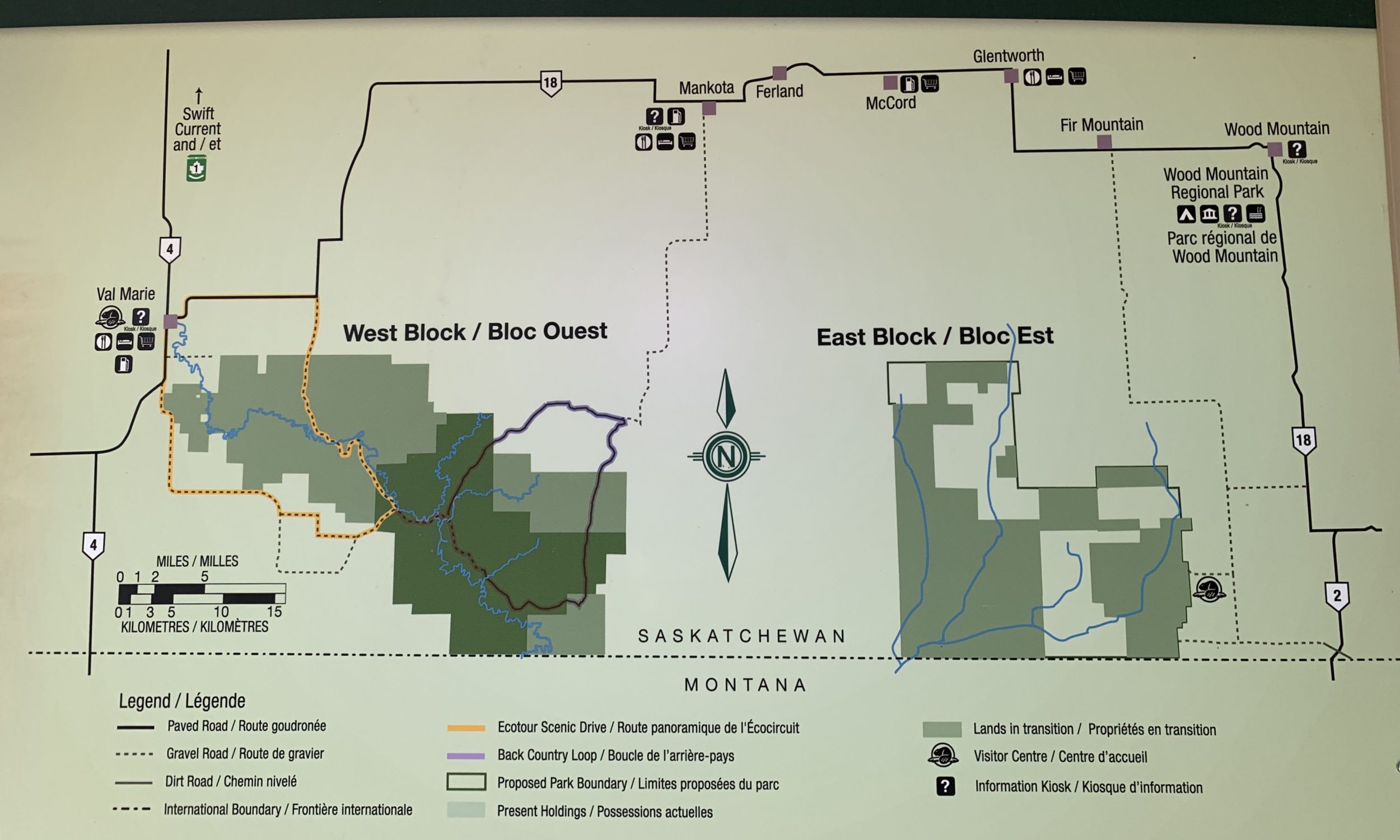
Grasslands National Park is located in southern Saskatchewan, Canada, next to the US border into Montana. The national park is roughly 3.5 hours drive from Regina or 4 hours drive from Saskatoon.
Grasslands National Park has two separate blocks: the West Block and the East Block, with a pretty big gap in the middle. The Grasslands West Block is near the small town of Val Marie (population a grand total of one hundred and something). The East Block is roughly 150km away.
Grasslands National Park Landscape
Grasslands National Park is one of Canadas largest remaining native prairie grasslands. While both blocks represent the grasslands (funny that!), each is characterised by distinct landscapes. The West Block is dominated by endless prairie grasslands and the Frenchman Valley River, and is home to endangered animals like bison and black tailed prairie dogs. The East Block landscape is more rugged, and features badlands terrain with dinosaur fossils.
Like much of Saskatchewan, Grasslands can get overlooked in favour of the more dramatic mountains and lakes of the nearby Canadian Rockies, such as Banff National Park. While the beauty of the prairies is more subtle and desolate, that’s exactly the reason why it’s worth visiting: to feel small in the endless plains and be at one with nature. In fact, Grasslands National Park only gets around 20,000 visitors annually. It’s quite possible to feel like you’re the only people in the park.
Grasslands National Park Wildlife
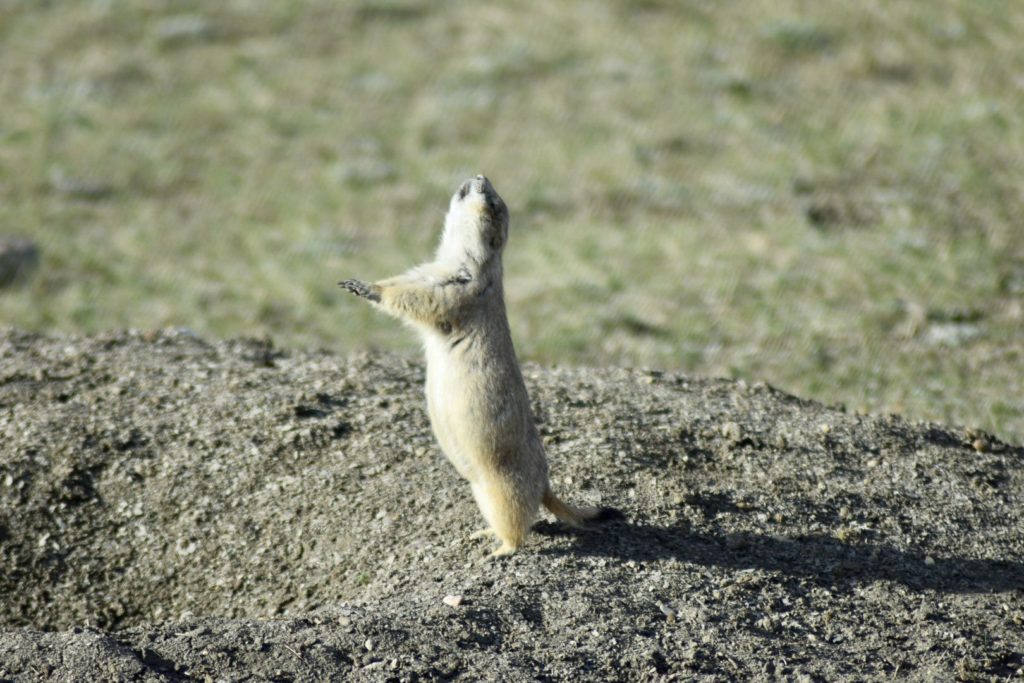
Bison: Grasslands National Park has herds of wild plains bison, which were reintroduced to the park after having disappeared for 120 years. You have good chances of spotting plains bison on the Ecotour Scenic Drive or hiking trails (see further below).
Prairie Dogs: Grassland National Park is home to the only native black tailed prairie dogs in Canada. Nope, a prairie dog isn’t a jackal like animal as I first thought, but instead resembles a large ground squirrel or gopher. See cute pic above! Prairie dogs are super cute and social animals, and will bark (more like chirp!) and wag their tails as you walk past. The prairie dog towns are marked on local park maps, and cover a surprisingly large area. Look out for little mounds of dirt and you’ll see them pop in and out of their burrows.
Deer: Deer are common in Grasslands National Park, including pronghorn antelope with distinctive markings, mule deer with massive ears, and white tailed deer with floofy tails that stick straight up when they’re alarmed. The deer are a bit skittish, and tend to run when people are around.
Other Wildlife: Grasslands has a range of other animals and birds, including coyote, burrowing owls (comical looking birds on stilts), rattlesnakes, jackrabbits, black footed ferrets and even elusive bobcats according to one park signboard. Many of the species hibernate or migrate during the harsh winter.
Best Time to Visit Grassland National Park
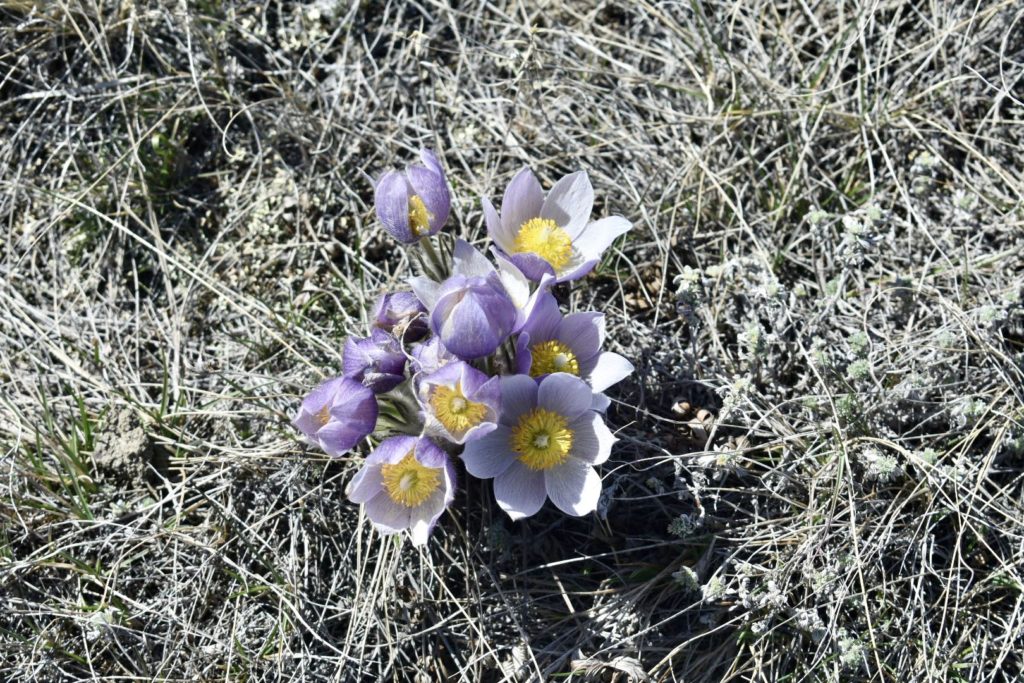
Like most of Saskatchewan, Grasslands National Park has hot summers, bitterly cold winters, lots of wind, little rain, and quickly changing weather conditions. Grasslands National Park is open year round. However, the park’s facilities are only open during the May to October season, including the visitors centre and the campground.
The best time to visit Grassland National Park is during or close to the open season. Winter (December to February) in southern Saskatchewan is pretty bitter, with temperatures well below freezing and occasional snow. Summer (June to August) can be surprisingly hot, with temperatures in the mid to late 20s or even hotter, especially in the East Block badlands.
Late May to June is a beautiful time to visit Grasslands. During this time, the temperatures are pleasant, the grass is green once again, the migratory birds have returned and spring flowers carpet the park.
We visited outside the ‘season’ in April when the weather can be somewhat temperamental. Luckily, we were treated to sunny (but windy!) days in the teens, and virtually no visitors. We only saw a couple of cars and one hiker in the distance during three days in the West Block. The landscape was a little brown during this time, but the first signs of spring were appearing with the odd wildflower and animals returning to the plains.
Grasslands National Park Accommodation
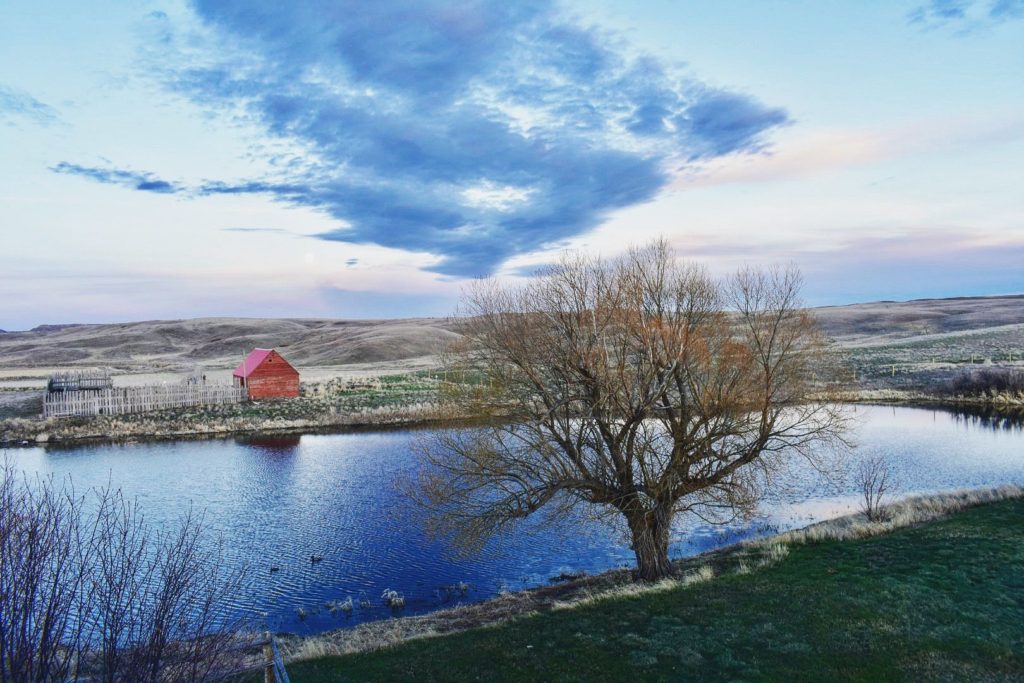
The Grasslands West Block has a few accommodation options to suit all types of travelers. Some of the accommodation is seasonal.
The Crossing at Grasslands: We stayed at The Crossing at Grasslands, which has three self catering units right on the doorstep of the West Block of Grasslands, near the 70 Mile Butte access road and less than 10 minutes drive from Val Marie. The location is tranquil, the hosts are lovely, and the units have everything you need for a comfortable stay, including a kitchen and BBQ. I particularly loved watching all the ducks and bird life in the pond in front of our unit (evidence above!).
The Convent Inn: As you may have guessed from the name, The Convent Inn is an old convent that has been restored into a country inn.
Val Marie Hotel: The Val Marie Hotel is in Val Marie town and has the only restaurant in town, serving Canadian and Chinese cuisine,
Camping: Grasslands National Park has camping options to suit all types of campers (note: not necessarily all types of travelers!), including front country camping, back country camping, equestrian camping, and even tipis and permanent tents. The Frenchman Valley Campground in the West Block and the Rock Creek Campground in the East Block both offer seasonal tent / RV electric campsites and oTENTik units (mix of cabin and tents with beds, heating and electricity). Seasonal tipis are available at the Two Trees Day Area in the West Block and at the Rock Creek Campground in the East Block.
Grasslands Ecotour Scenic Drive
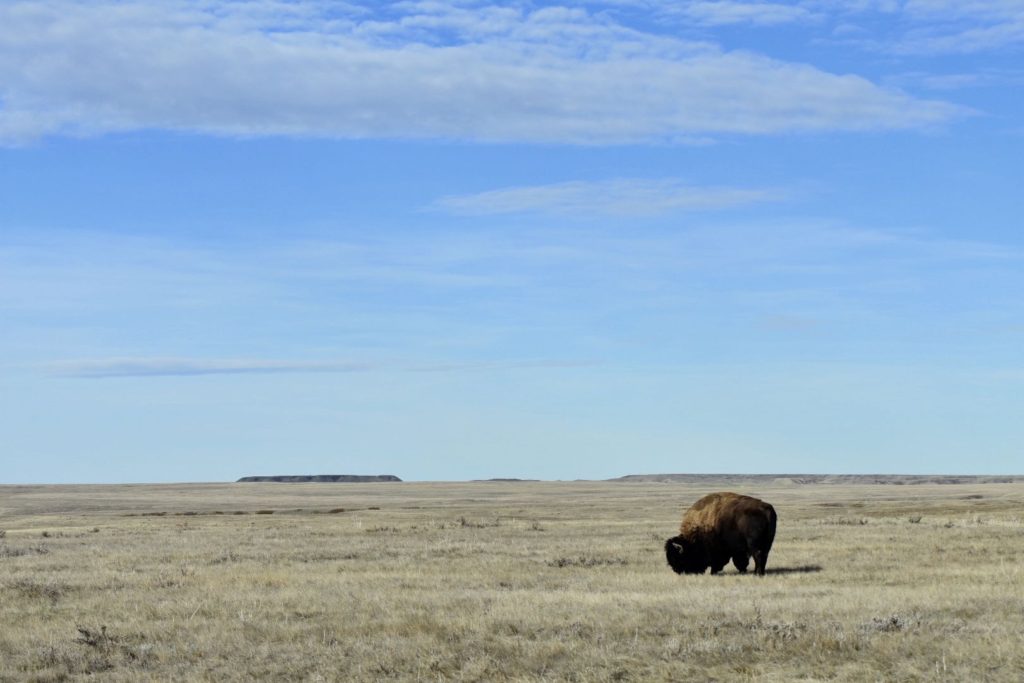
The Grasslands Ecotour Scenic Drive, also known as the Ecotour Road, is an 80km loop around the West Block of Grasslands National Park, and is the main road around the West Block. The road is marked in yellow in the park maps, above and below.
There’s 7 official ‘stops’ on the Ecotour Scenic Route, plus other campgrounds, day use areas and trails. Along the way, there’s plenty of viewpoints and hiking trails, and excellent wildlife spotting opportunities. The Ecotour Drive is perfect if you’re short on time, or to make a day (or two!) of it by walking some of the hiking trails.
Stop 1 – Boundary Gate
The first stop on the Ecotour Drive is at the boundary entrance gate to Grasslands National Park, and has nice views to 70 Mile Butte. We stayed close to our car as two rather large bison were chillaxing right next to the fence (see photo above!). A pretty good start to our wildlife viewing!
Stop 2 – Top Dogtown Trail
Next up is the short Top Dogtown Trail (Hike #1 below). Top Dogtown is a massive town of black tailed prairie dogs. This was a personal fav of mine, as I’m an absolute sucker for cute critters. See further under Hike #1 below.
Stop 3 – Turgluch Route
Stop 3 is the start of the Turgluch Route (Hike #2 below), the end (or start!) of the one way Bearpaw Sea Trail (Hike #10 below), and also has a few information boards about the Grasslands.
Stop 4 – Views
Here you’ll find more sweeping views over the endless prairies, and good photo opportunities.
Stop 5 – Cattle Ranch
Stop 5 is the site of an old cattle ranch. There’s nice views of the river if you walk around 100m to the signs.
The Belza Day Use area is in between Stop 5 and 6. Hikes #3 and 4 start from the Belza Day Use Area. The area also has picnic tables and a toilet.
Stop 6 – Larson Interpretive Trail
The Larson Interpretive Trail (Hike #5 below) is a short easy track around an old cowboy ranch.
Stop 7 – Larson Dogtown
Another fan favourite, Larson Dogtown is a large colony of prairie dogs, with telescopes for views over the plains. Cuteness galore!
Hikes # 6-10 below are after Stop 7, on the way back to Val Marie.
Grasslands National Park Hikes – West Block
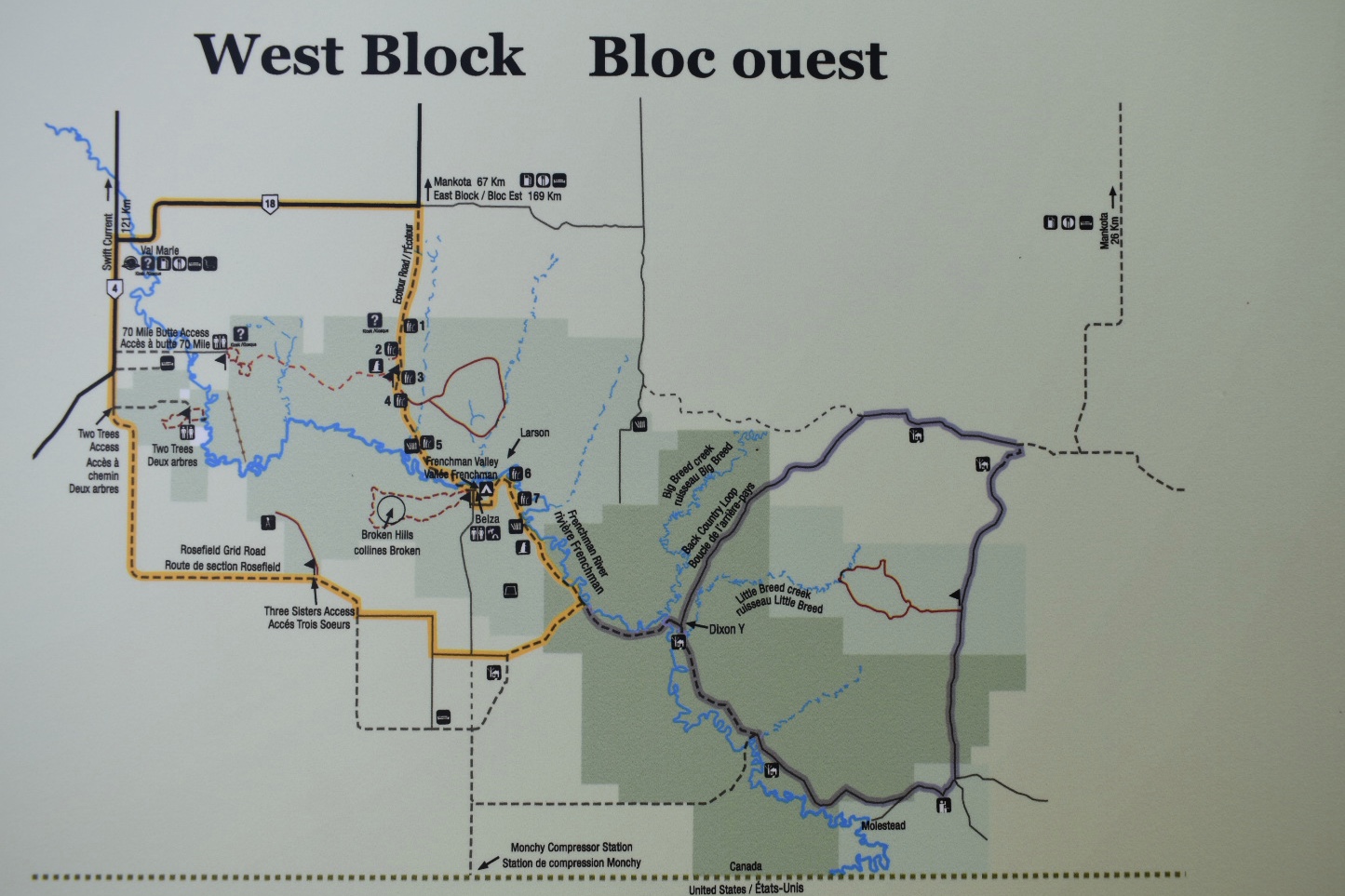
Ecotour Route Hikes: The Grasslands National Park West Block has 10 hikes along the Ecotour Scenic Drive, listed below starting clockwise from Val Marie. My personal favourites were the 70 Mile Butte Trail for endless prairie views and the Broken Hills Trail for a longer scenic hike.
Other Hikes: In addition to the Ecotour hikes, the Otter Basin Route starts off the Back Country Loop Road in the West Block. When we visited, most of the Back Country Loop was unfortunately closed as part of the road was washed out. The East Block also has several hiking trails and routes, which we didn’t have time to get to as it’s around 1.5 hours drive from the West Block to the East Block.
Trail vs. Route: The Grasslands National Park hikes are either a ‘trail’ or a ‘route’. A trail is a defined trail, often with yellow markers. A route is less defined, and requires navigation skills – either the ability to follow directions or use a compass.
Difficulty Ratings: The difficulty ratings below are the Canada National Park ratings. I generally rated the trails one degree easier than the CNP ratings, particularly as there are no long climbs (this is the flat prairies after all!) or particularly technically difficult sections. When a hike is rated ‘difficult’, I would add ‘difficult for Grasslands’. The hikes were also much quicker than the Parks Canada estimates.
1. Top Dogtown Trail
Distance: 750m
Difficulty: Easy
Start Point: Ecotour Road Stop #2
Top Dogtown Trail is an easy flat loop through a massive town of super sweet black tailed prairie dogs. I loved watching the dogs pop in and out of their burrow homes, and hearing their protective barks (which sound more like a tweeting bird!) as we walked past. The trail has gorgeous views over the valley and telescopes to scout for animals.
2. Timbergulch Route
Distance: 17km loop
Difficulty: Difficult
Start Point: Ecotour Road Stop #3. The trail starts at the end of the Bearpaw Sea Trail (#10 below).
Timbergulch Route is a longer hike with three coulee (valley) bottoms created by glaciers. Bison spotting chances are particularly favourable along this route.
3. Broken Hill Trail
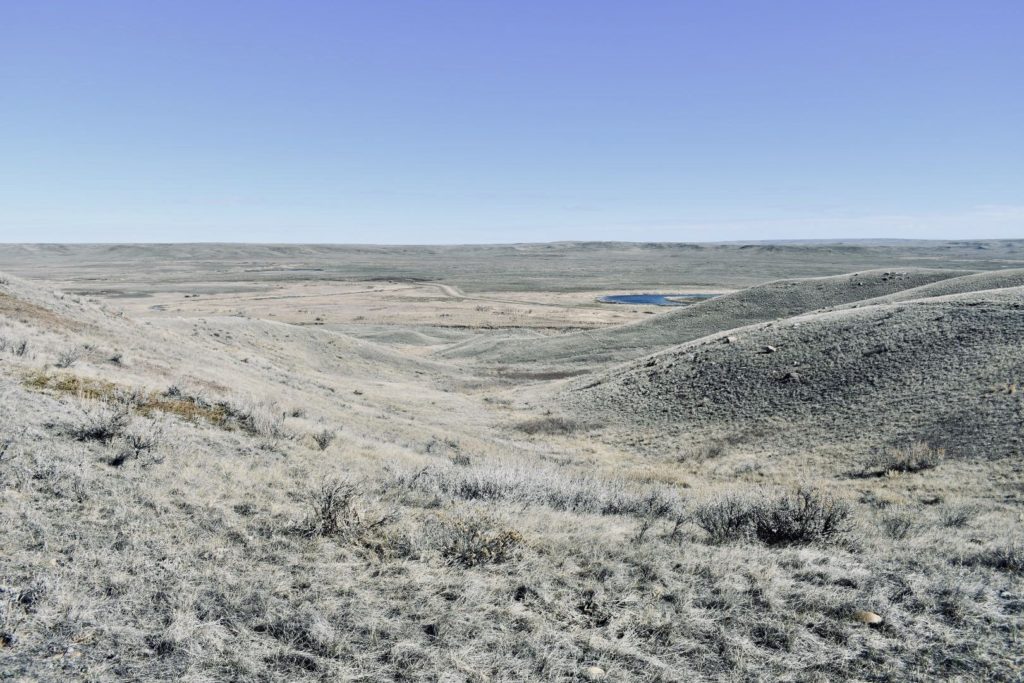
Distance: 11.2km loop
Difficulty: Difficult
Start Point: Ecotour Road at Belza Day Use Area. The Broken Hill Trail starts on opposite side of road from the Day Use Area.
The Broken Hill Trail is a loop trail through classic grasslands terrain, with rolling hills and wide open vistas every which way you look. While the Parks Canada rating is difficult, I’d rate this hike as moderate. There’s undulating hills, uneven ground, and the hike is a bit longer, but there’s no big climbs or scrambling involved.
Broken Hills Trail took us around 3 hours from the Belza Day Use Area, including one short break. We saw plenty of bison and deer along the way, and even one curious coyote in the distance – a highlight of our three days in Grasslands.
4. Tipi Ridge Trail
Distance: 2km loop
Difficulty: Moderate
Start Point: Ecotour Road at Belza Day Use Area
The Tipi Ridge Trail is a short loop along a ride with views over the Frenchman Valley. Lookout for tipi rings as you walk.
5. Larson Interpretive Trail
Distance: 1.4km loop
Difficulty: Easy
Start Point: Ecotour Road Stop #6
The Larson Interpretive Trail is a short easy loop with information boards about a local cowboy. Keep an eye an ear open for the inquisitive prairie dogs which make this area their home.
6. Three Sisters Route
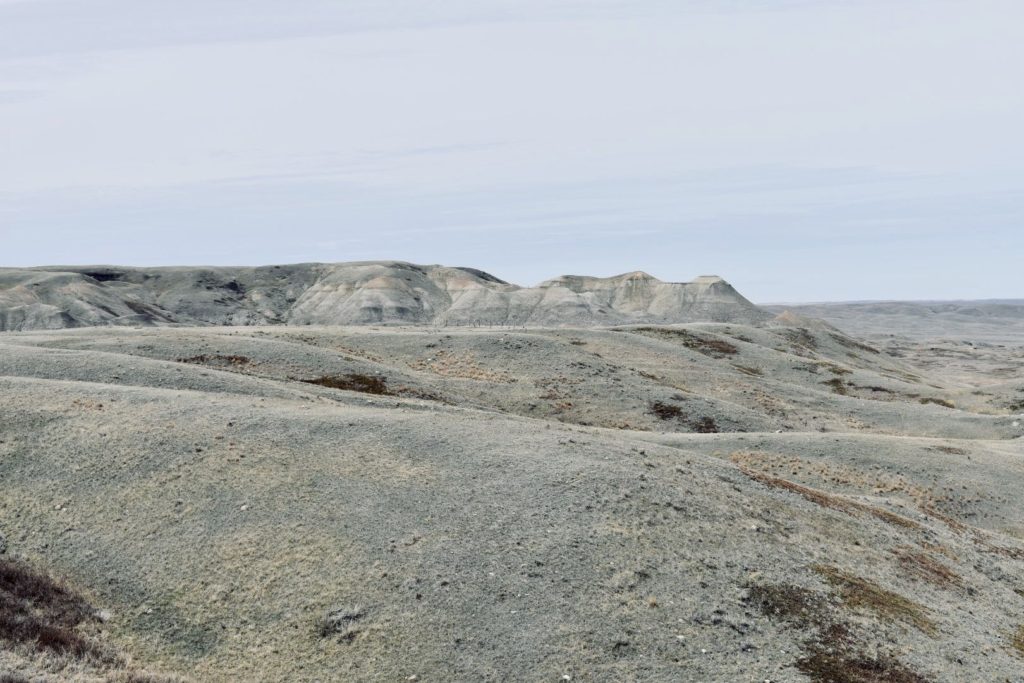
Distance: 4km one way
Difficulty: Moderate
Start Point: Ecotour Road at Three Sisters Access
The Three Sisters Route traverses an easy country trail which ends with dramatic views of the Three Sisters hills, and then descends into a prairie dog colony in the valley. The route is easy to follow. Simply walk along the marked trail until you hit the tower with views to the Three Sisters, then walk down to your right and you’ll see a large prairie dog colony and small stone monument where the track ends. The Three Sisters Route took us 1 hour 45 minutes return.
7. Riverwalk Trail
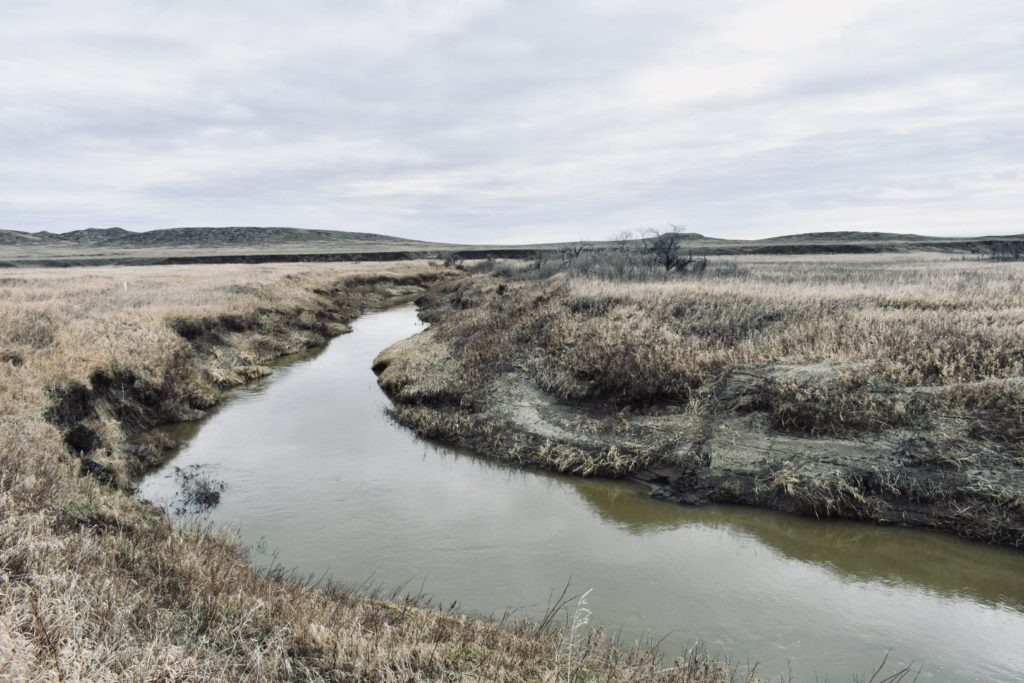
Distance: 3.3km loop
Difficulty: Easy
Start Point: Ecotour Road at Two Trees Trail Access
The Riverwalk Trail is a pleasant easy walk along the river and through different types of reedy grasses. The trail took us 45 minutes with small detours, as two parts of the trail were washed out.
8. Two Trees Trail
Distance: 4km loop
Difficulty: Moderate
Start Point: Ecotour Road at Two Trees Trail Access
The Two Trees Trail combines well with the Riverwalk Trail, as both walks start at the Two Trees Trail Access. The trail follows yellow markers through undulating hills, with only small inclines. You’ll be treated to great views back to 70 Mile Butte. We saw lots of deer along this trail.
9. Eagle Butte Trail and 70 Mile Butte Trail
Distance: 4.1km loop for both trails. If you want a short walk, you can just do the 2km Eagle Butte Trail.
Difficulty: Eagle Butte Trail is rated moderate and 70 Mile Butte Trail is rated difficult. I would rate the full hike as moderate, due to the small climbs and slightly soft uneven ground.
Start Point: Ecotour Road at 70 Mile Butte Access (off State Highway 4). There’s a toilet at the carpark.
Eagle Butte Hike and 70 Mile Butte Hike are some of the most popular hikes in all of Grasslands National Park, and for good reason. 70 Mile Butte is one of the highest points in the flat Saskatchewan prairies with expansive views over the park, but at 145m elevation the hike isn’t exactly tiring. The two trails form a figure of 8, and took us around 1 hour 15 minutes for both loops.
Eagle Butte and 70 Mile Butte would be my pick for a Grasslands National Park hike if you’re just passing through the area, as the hike is reasonably short, particularly beautiful, and starts not far off the main road just after Val Marie.
10. Bearpaw Sea Trail
Distance: 10km one way
Difficulty: Difficult
Start Point: The trail starts at the end of 70 Mile Butte Trail and ends at Ecotour Road Stop #3 (or vice versa). The trail is one way trail so pick up required unless you fancy a very long walk!
The Bearpaw Sea Trail is a one way trail with a diverse variety of landscapes along the way. The trail would combine well with the Eagle Butte and 70 Mile Butte if you wanted a longer one way hike (around 14km) and could organise pick up at the other end.
Grasslands National Park Travel Tips
The gist of my tips is to come prepared for a trip to Grasslands National Park! Grasslands is a little more remote than many western Canadian National Parks, and has limited facilities. Embrace the serenity!
Maps and Information: Grab some maps from the Grasslands National Park Visitors Centre (just before Val Marie) when you arrive and plan your driving routes and hiking trails. There’s limited cellphone reception in the park.
Facilities: Grasslands National Park and its surrounds have limited facilities, so come prepared with supplies. Val Marie has a well stocked town store, along with one restaurant (at the Val Marie Hotel) and a seasonal cafe.
Weather: The weather in Saskatchewan is a fickle beast, and can change multiple times per day at the flick of a switch. Always bring extra layers when hiking. When we enquired about the April weather, we were told that it varies between snow and a lovely 20 degrees celsius! In our few days in the park, my attire changed from a sleeveless top to three layers plus a jacket.
Wildlife: Stay at least 100m away from bison, and keep your eyes (and ears!) open for rattlesnakes.
Trails: Some of the Grasslands trails are not well marked and require orienteering or navigation skills. ‘Trails’ are defined, ‘routes’ are less defined. Plan your hike in advance, and take note of landmarks along the way (such as they are in the flat prairies!).
Like It? Pin It!
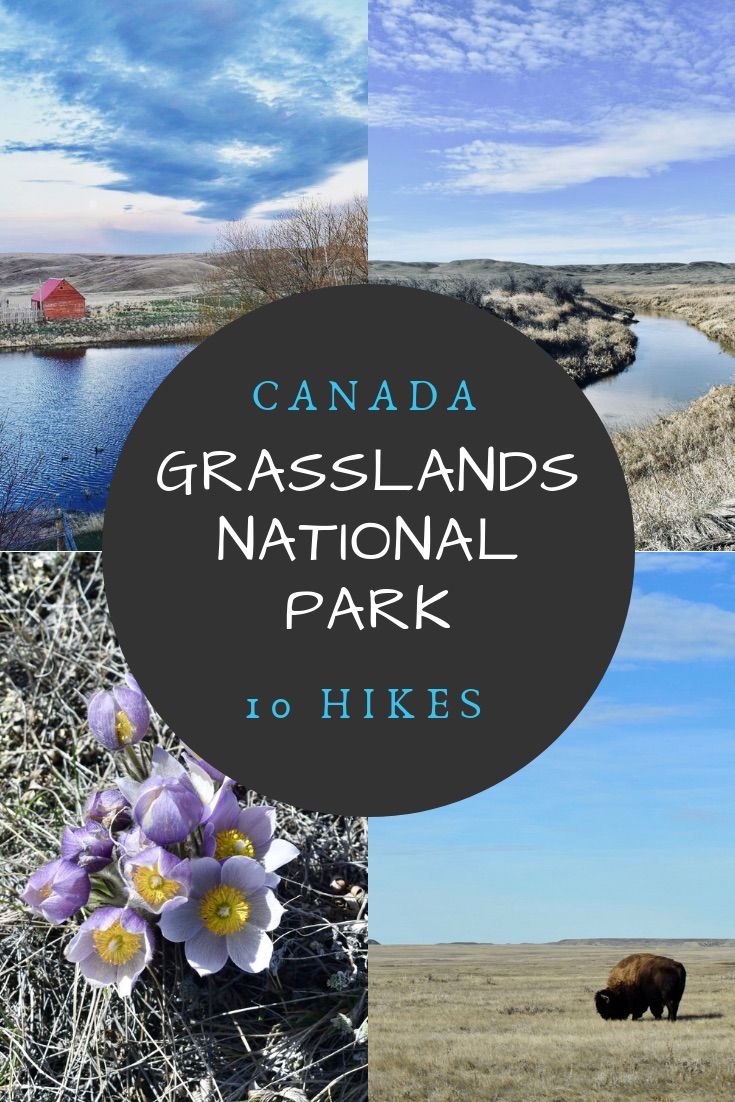
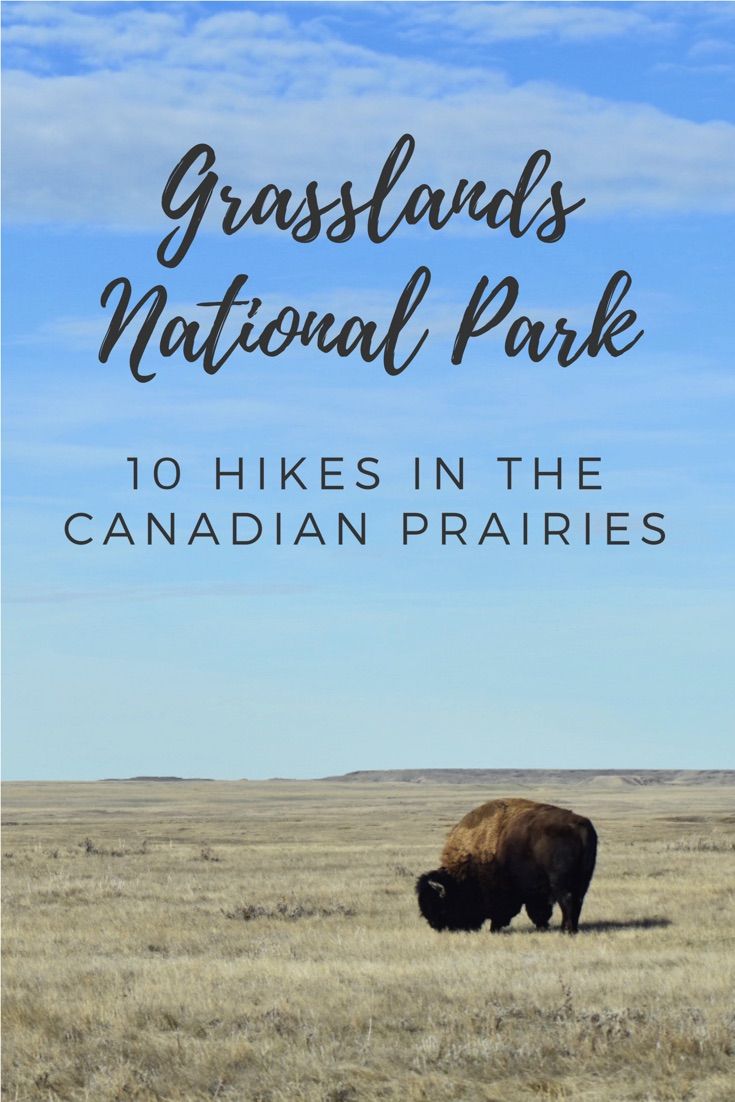
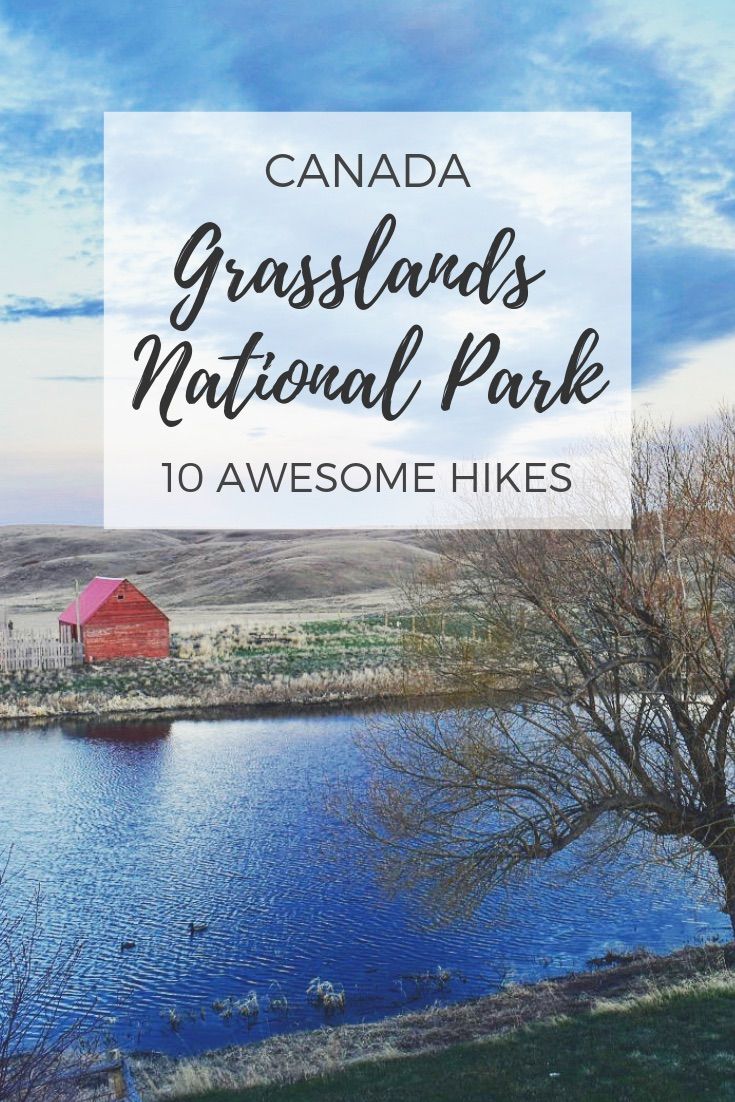

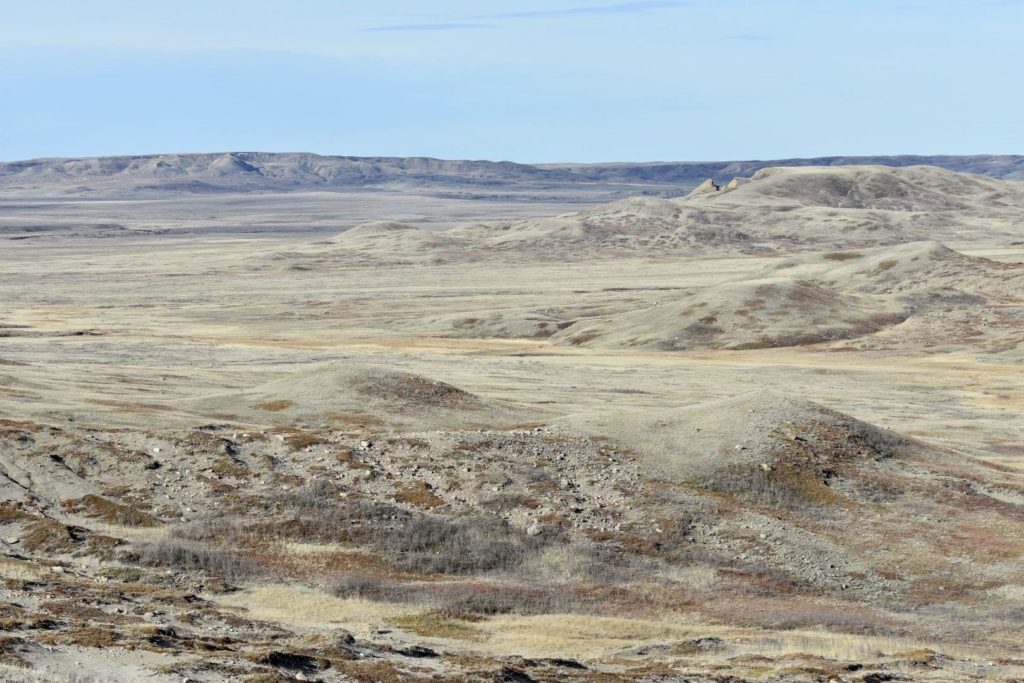
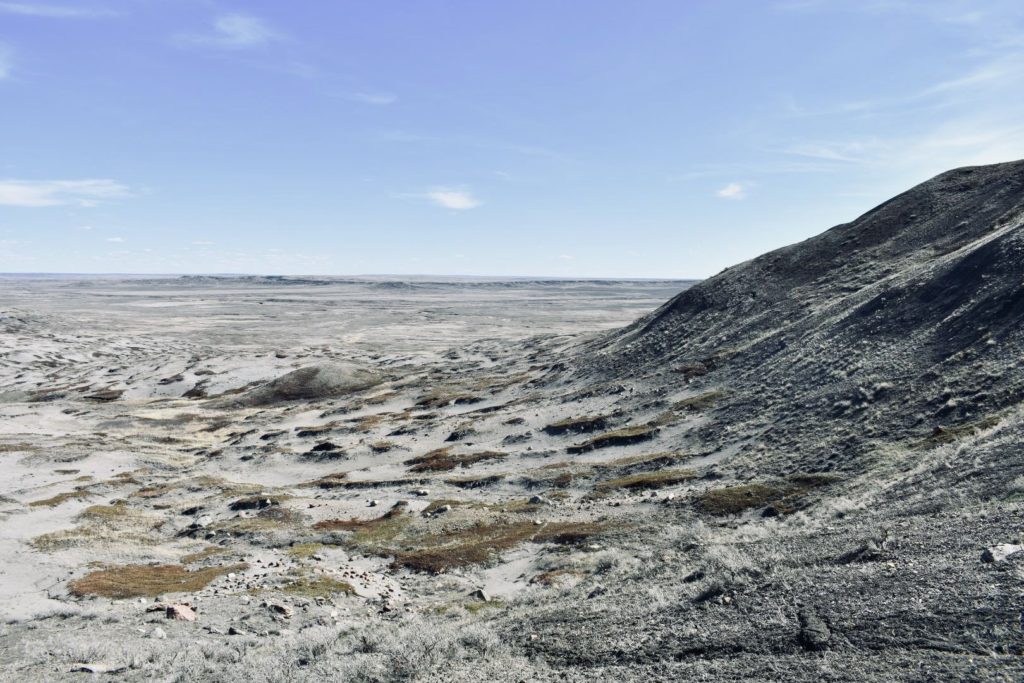
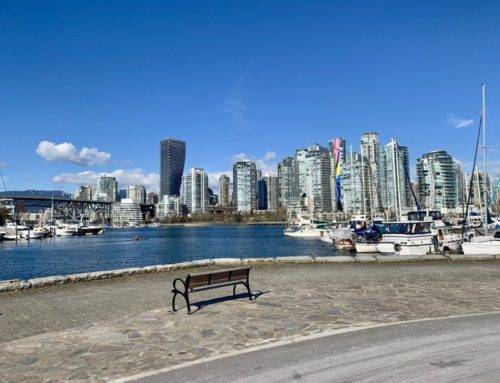
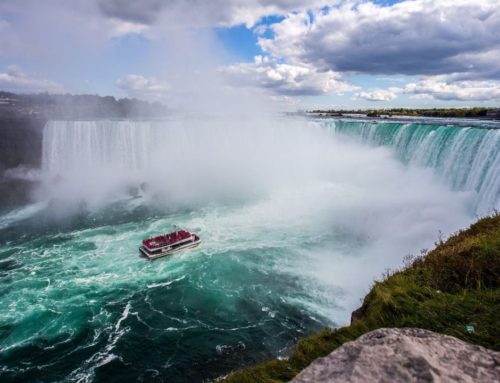


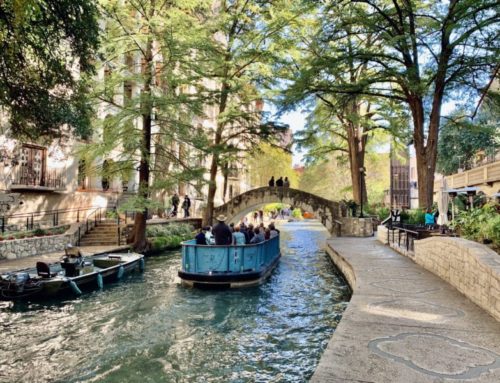
Leave A Comment